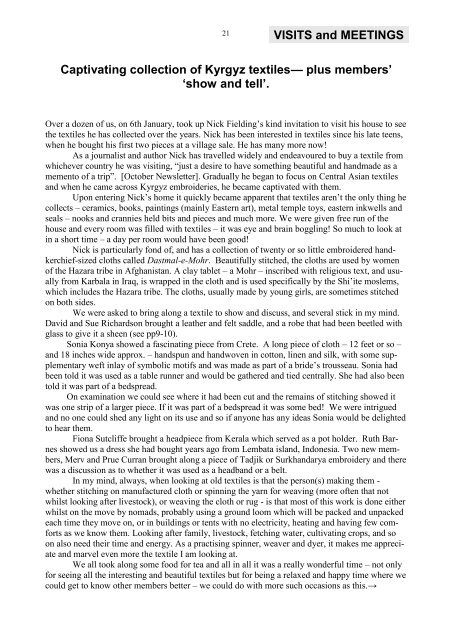Download - OATG. Oxford Asian Textile Group
Download - OATG. Oxford Asian Textile Group
Download - OATG. Oxford Asian Textile Group
You also want an ePaper? Increase the reach of your titles
YUMPU automatically turns print PDFs into web optimized ePapers that Google loves.
21<br />
VISITS and MEETINGS<br />
Captivating collection of Kyrgyz textiles— plus members’<br />
‘show and tell’.<br />
Over a dozen of us, on 6th January, took up Nick Fielding‘s kind invitation to visit his house to see<br />
the textiles he has collected over the years. Nick has been interested in textiles since his late teens,<br />
when he bought his first two pieces at a village sale. He has many more now!<br />
As a journalist and author Nick has travelled widely and endeavoured to buy a textile from<br />
whichever country he was visiting, ―just a desire to have something beautiful and handmade as a<br />
memento of a trip‖. [October Newsletter]. Gradually he began to focus on Central <strong>Asian</strong> textiles<br />
and when he came across Kyrgyz embroideries, he became captivated with them.<br />
Upon entering Nick‘s home it quickly became apparent that textiles aren‘t the only thing he<br />
collects – ceramics, books, paintings (mainly Eastern art), metal temple toys, eastern inkwells and<br />
seals – nooks and crannies held bits and pieces and much more. We were given free run of the<br />
house and every room was filled with textiles – it was eye and brain boggling! So much to look at<br />
in a short time – a day per room would have been good!<br />
Nick is particularly fond of, and has a collection of twenty or so little embroidered handkerchief-sized<br />
cloths called Dastmal-e-Mohr. Beautifully stitched, the cloths are used by women<br />
of the Hazara tribe in Afghanistan. A clay tablet – a Mohr – inscribed with religious text, and usually<br />
from Karbala in Iraq, is wrapped in the cloth and is used specifically by the Shi‘ite moslems,<br />
which includes the Hazara tribe. The cloths, usually made by young girls, are sometimes stitched<br />
on both sides.<br />
We were asked to bring along a textile to show and discuss, and several stick in my mind.<br />
David and Sue Richardson brought a leather and felt saddle, and a robe that had been beetled with<br />
glass to give it a sheen (see pp9-10).<br />
Sonia Konya showed a fascinating piece from Crete. A long piece of cloth – 12 feet or so –<br />
and 18 inches wide approx. – handspun and handwoven in cotton, linen and silk, with some supplementary<br />
weft inlay of symbolic motifs and was made as part of a bride‘s trousseau. Sonia had<br />
been told it was used as a table runner and would be gathered and tied centrally. She had also been<br />
told it was part of a bedspread.<br />
On examination we could see where it had been cut and the remains of stitching showed it<br />
was one strip of a larger piece. If it was part of a bedspread it was some bed! We were intrigued<br />
and no one could shed any light on its use and so if anyone has any ideas Sonia would be delighted<br />
to hear them.<br />
Fiona Sutcliffe brought a headpiece from Kerala which served as a pot holder. Ruth Barnes<br />
showed us a dress she had bought years ago from Lembata island, Indonesia. Two new members,<br />
Merv and Prue Curran brought along a piece of Tadjik or Surkhandarya embroidery and there<br />
was a discussion as to whether it was used as a headband or a belt.<br />
In my mind, always, when looking at old textiles is that the person(s) making them -<br />
whether stitching on manufactured cloth or spinning the yarn for weaving (more often that not<br />
whilst looking after livestock), or weaving the cloth or rug - is that most of this work is done either<br />
whilst on the move by nomads, probably using a ground loom which will be packed and unpacked<br />
each time they move on, or in buildings or tents with no electricity, heating and having few comforts<br />
as we know them. Looking after family, livestock, fetching water, cultivating crops, and so<br />
on also need their time and energy. As a practising spinner, weaver and dyer, it makes me appreciate<br />
and marvel even more the textile I am looking at.<br />
We all took along some food for tea and all in all it was a really wonderful time – not only<br />
for seeing all the interesting and beautiful textiles but for being a relaxed and happy time where we<br />
could get to know other members better – we could do with more such occasions as this.→

















